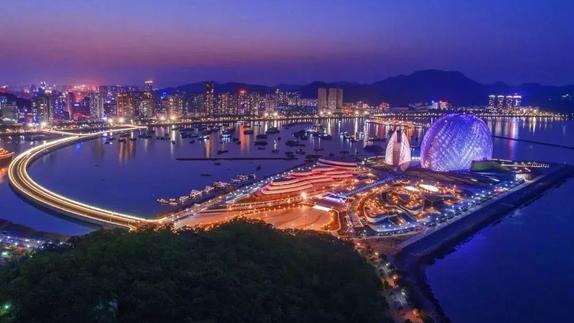 This undated photo shows a night view of Zhuhai, a Guangdong province city in the Guangdong-Hong Kong-Macao Greater Bay Area city cluster. (PHOTO / CHINA DAILY)
This undated photo shows a night view of Zhuhai, a Guangdong province city in the Guangdong-Hong Kong-Macao Greater Bay Area city cluster. (PHOTO / CHINA DAILY)
The Guangdong-Hong Kong-Macao Greater Bay Area could become the new engine driving China’s economic growth, but greater efforts are needed on industrial upgrades and technological innovation to strengthen its late-mover advantage, according to experts and business leaders.
The Bay Area is a major market carrier for China to carry out “dual circulation”, the new development pattern put forward by the country’s leadership in which internal economic circulation is the mainstay while domestic and external markets complement each other. It is also an important driving force for the country’s future development, said Guan Qingyou, dean and chief economist at Reality Institute of Advanced Finance.
Compared with the other three bay areas in the world — New York’s, San Francisco’s, and Tokyo’s — the Guangdong-Hong Kong-Macao Greater Bay Area has advantages in both soft power and hardware facilities
ALSO READ: Shenzhen miracle to GBA innovation
Compared with the other three bay areas in the world — New York’s, San Francisco’s, and Tokyo’s — the Guangdong-Hong Kong-Macao Greater Bay Area has advantages in both soft power and hardware facilities. But in terms of innovation capacity, gross domestic product per capita and other indicators that reflect long-term competitiveness, it still has some way to go, he said.
“More efforts should be made on accelerating the transformation of development model and upgrading industry structure in the Bay Area so that late-mover advantages of the area could be developed,” Guan said at a forum in Shenzhen on Monday.
Guan’s view was echoed by Zhou Qiren, a professor with the National School of Development at Peking University. Zhou warned that China’s cost advantage in the past 40 years is gradually fading, but the country has yet to form a unique advantage.
To address the challenge, Zhou urged Chinese enterprises to pour more resources and energy into technological innovation and strengthen their late-mover advantage.
ALSO READ: Greater financial support for Greater Bay Area
“Entrepreneurial spirit should be redefined,” he said. “In the past, efforts to lead people to affluence, to make good products, to fulfill social responsibility were called entrepreneurial spirit. Now and in the future, Chinese enterprises should focus more on enhancing the ‘uniqueness’ of technological innovation and strengthening late-mover advantage in innovation.”
Li Zibin, president of the China Association of Small and Medium-Sized Enterprises, said Shenzhen, with its sound business and entrepreneurial environment, could play a significant role in the process.
Since 1995, the Shenzhen government has viewed technological innovation as the “primary driver of economic development” and positioned high-tech industry as the “primary growth point of economic development”, Li said.
ALSO READ: GBA: Guangdong, HK, Macao cooperate for leisure, healthcare
Thanks to its favorable business and entrepreneurial environment, Shenzhen was able to nurture a number of leading enterprises such as Tencent, Huawei, Ping An and DJI and create the “Shenzhen spirit” of innovation, inclusiveness and boldness, he added.
Sheng Ruisheng, board secretary and brand director of insurance giant Ping An Group, said the “Shenzhen spirit” has been deeply implanted into Ping An’s corporate culture.
The rapid development of Ping An in its 32 years of history can be attributed to its perseverance in innovation and the company will continue to promote technological innovation to make new breakthroughs in the future, he said.
READ MORE: Sci-tech center to lift Greater Bay Area prospects


